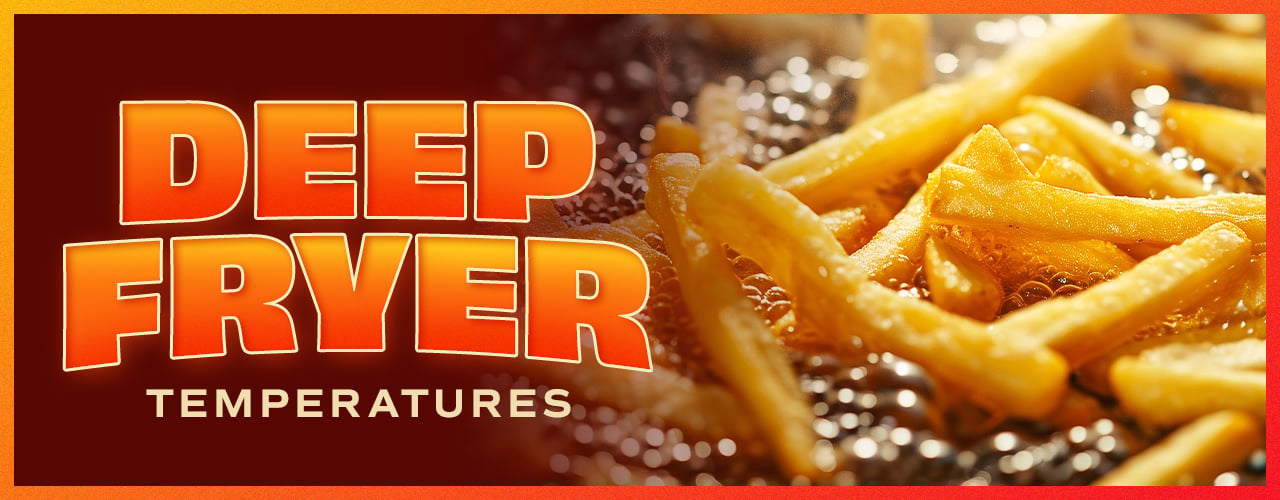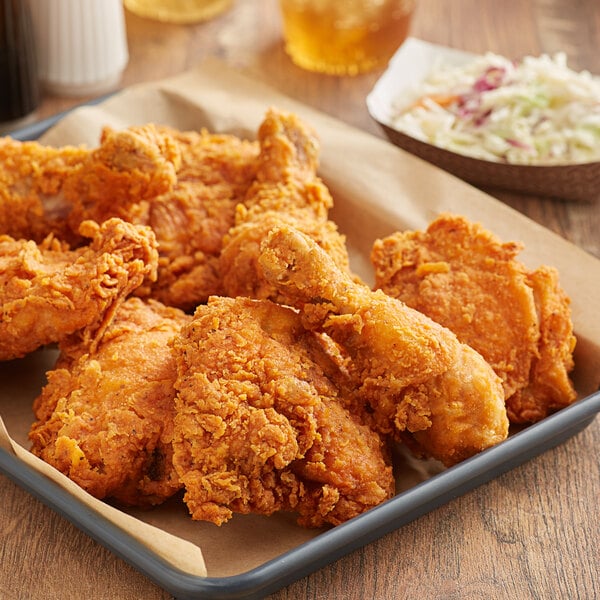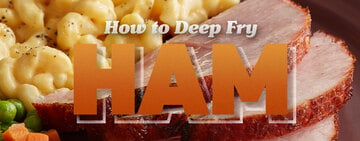
To achieve the best possible results when deep frying, it is crucial to understand the significance of oil temperatures. Deep frying at the ideal temperature cooks food thoroughly and results in a crispy, golden exterior. Whether you are starting a concession stand or seeking training resources for your line cooks, our comprehensive guide covers the optimal frying temperatures for various fried foods.
Average Temperature Range for Deep Frying
When it comes to deep frying, maintaining the correct temperature throughout the cooking process is critical for achieving the perfect texture and taste. The average temperature range for deep frying typically falls between 350 and 375 degrees Fahrenheit, or 175 to 190 degrees Celsius when you need to convert the temperature. If you deep fry foods at too low a temperature, food may not cook evenly and can absorb excess oil, resulting in a greasy and soggy end product. On the other hand, if you fry at too high of a temperature, it can cause food to burn on the outside while remaining undercooked on the inside. Commercial deep fryers often come equipped with built-in thermostats or digital controls to ensure accurate temperature control. These features allow chefs and kitchen staff to easily monitor and adjust the temperature throughout the cooking process, ensuring consistent results every time.
Temperature for Deep Frying Chicken

You should fry your chicken between 350 and 375 degrees Fahrenheit (175 degrees Celsius to 190 degrees Celsius), and the oil temperature should never fall below 325 degrees Fahrenheit (163 degrees Celsius). The temperature and cooking time for frying chicken can vary depending on the size and thickness of the pieces. For instance, chicken wings are smaller and have less meat than chicken tenders or thighs, so they will need a higher oil temperature but a shorter cooking time.
No matter what type of chicken you’re frying, use a meat thermometer to make sure that the internal temperature reaches 165 degrees Fahrenheit (74 degrees Celsius) and the chicken is fully cooked. We’ll go over the oil temperatures and cooking times for different chicken types below:
- Fried Chicken: 350 degrees Fahrenheit for 8-15 minutes
- Chicken Tenders: 350 degrees Fahrenheit for 5-7 minutes
- Chicken Wings: 375 degrees Fahrenheit for 10-15 minutes
Temperature for Deep Frying Fish and Shellfish

If you’re looking to create the perfect battered fish, lean white fish are the best candidates for deep frying. The temperature and cooking time for frying seafood can vary depending on the size and thickness of the pieces. No matter what type of fish or shellfish you’re frying, use a thermometer to make sure that the internal temperature reaches 145 degrees Fahrenheit (63 degrees Celsius) and the fish is fully cooked. Different types of seafood require specific oil temperatures and cooking times. Below are the temperatures and cooking times for deep frying popular seafood items:
- Battered Fish: 350-375 degrees Fahrenheit for 3-6 minutes
- Shrimp: 375 degrees Fahrenheit for 1-2 minutes
- Calamari: 375 degrees Fahrenheit for 2-3 minutes
- Prawns: 350 degrees Fahrenheit for 3-4 minutes
- Oysters: 350-375 degrees Fahrenheit for 1-2 minutes
Temperature for Deep Frying French Fries

To get that perfectly crispy and golden exterior, while maintaining a soft and fluffy interior, deep fry your french fries twice. The first fry partially cooks the fries and removes excess moisture while the second guarantees a crispy product. Before the second fry, let the fries cool until they are almost ready to serve. This step allows the fries to rest and further dry out, ensuring a crispier final result.
By following the correct temperature and cooking guidelines below, you can ensure that your french fries turn out just right every time.
- First Fry: 325 degrees Fahrenheit for 3-6 minutes
- Second Fry: 375 degrees Fahrenheit for 2-3 minutes
Temperature for Deeping Frying Common Foods
In addition to chicken, fish, and french fries, here are the oil temperatures and cooking times for other commonly deep-fried foods:

- Vegetables: 375 degrees Fahrenheit for 1-2 minutes
- Onion Rings: 375 degrees Fahrenheit for 2-3 minutes
- Mozzarella Sticks: 350 degrees Fahrenheit for 2-3 minutes
- Hush Puppies: 375 degrees Fahrenheit for 2-3 minutes
- Corn Dogs: 375 degrees Fahrenheit for 4-5 minutes
- Cheese Curds: 375 degrees Fahrenheit for 1-2 minutes
- Potato Chips: 350 degrees Fahrenheit for 3-4 minutes
- Spring Rolls: 350 degrees Fahrenheit for 3-4 minutes
- Donuts: 375 degrees Fahrenheit for 2-3 minutes
- Churros: 375 degrees Fahrenheit for 3-4 minutes
- Funnel Cake: 350 degrees Fahrenheit for 2-3 minutes
- Turkey: 350 degrees Fahrenheit for 3 1/2-4 minutes per pound
- Ham: 375 degrees Fahrenheit for 7 minutes per pound
Deep Frying Temperature Chart
Utilize our handy deep frying temperature chart as a reference guide in your kitchen. We have included the fry oil temperatures and cooking times for common fried food items.

Best Oils For Deep Frying
The oil you choose should have a high smoke point, which is the temperature at which the oil begins to break down and produce smoke. Oils with a high smoke point are more stable and can withstand the high temperatures required for deep frying without becoming rancid or imparting off-flavors to your food. Here are some of the best oils for deep frying:
- Peanut Oil: With a smoke point of around 450 degrees Fahrenheit, peanut oil is one of the most popular choices for deep frying. Its high smoke point allows it to maintain its stability and flavor even at high temperatures. Peanut oil also has a mild flavor that doesn't overpower the taste of the food being fried.
- Canola Oil: Canola oil has a smoke point of approximately 400 and 475 degrees Fahrenheit, making it another excellent option for deep frying. It is widely available and relatively affordable compared to other high smoke point oils. Canola oil is also low in saturated fats and cholesterol, making it a healthier choice for deep frying.
- Sunflower Oil: Sunflower oil has a smoke point of approximately 450 degrees Fahrenheit, making it suitable for deep frying. It is known for its light and mild flavor, which makes it a great choice for frying delicate foods. Sunflower oil is also rich in vitamin E and low in saturated fats.
- Avocado Oil: Refined avocado oil has a high smoke point between 480 to 520 degrees Fahrenheit and has a neutral flavor. High in unsaturated fatty acids, it is one of the healthiest oils for deep frying.
Deep Frying Tips
To achieve the perfect deep-fried results, here are some essential tips to keep in mind:

- Don't Overcrowd the Basket: When deep frying, it's crucial not to overcrowd the fryer basket with too much food. Overcrowding can lower the temperature of the oil, resulting in greasy and unevenly cooked food. To maintain the ideal frying temperature and ensure proper cooking, it's best to fry in smaller batches to give your food enough space.
- Monitor the Oil Temperature: Maintaining the correct oil temperature is essential for successful deep frying. If the oil is too hot, the food can burn on the outside while remaining undercooked inside. On the other hand, if the oil is not hot enough, the food will absorb more oil and potentially become too greasy. Use a deep fry thermometer to monitor the oil temperature closely and adjust the heat as needed.
- Let the Oil Come Back Up to Temperature: After adding a batch of food to the fryer, the oil temperature will drop. It's important to allow the oil to come back up to the desired temperature before adding the next batch so that each batch of food is cooked at the optimal temperature, resulting in consistent and delicious results.
- Avoid Putting Wet Food Into Hot Oil: Moisture and hot oil don't mix well. When adding wet food to hot oil, it can cause the oil to splatter and potentially result in burns. Additionally, the presence of moisture can cause the oil temperature to drop suddenly, leading to greasy and soggy fried foods. Always pat dry any food items before adding them to the fryer to prevent these issues.
- Fry Different Types of Foods Separately: Deep frying various foods in the same oil can lead to cross-contamination and potential allergen issues and affect the flavors of your dishes. It is especially important to prevent cross-contact when frying seafood. The distinct flavors and aromas of seafood can easily transfer to other foods, compromising their taste and increasing the risk of an allergic reaction. To avoid this, designate a separate fryer or oil for fish and shellfish. You may also want a designated fryer for french fries to promote them as gluten-free on your menu.
- Filter and Replace Oil Regularly: Over time, oil can become contaminated with food particles, debris, and burned bits, affecting the quality and taste of your fried foods. To achieve consistent results and prevent off-flavors, filter and replace the oil regularly. Follow the manufacturer's instructions for your specific deep fryer model on how to properly filter and dispose of used oil.
Frying foods at the ideal temperature for the correct amount of time is necessary to reach the perfect texture and flavor of your fried dishes. It ensures that your food cooks evenly, preventing it from becoming greasy, undercooked, or overcooked, and crisps up to a tempting golden color that will have your customers coming back for more.





